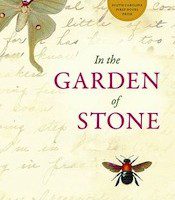A multi-generation novel is a risky thing. What gives it that unity that distinguishes a novel from a book of linked short stories? How does an author handle the passage of time or the death of her protagonist as one generation cedes to the next and the next?
Susan Tekulve’s debut novel, In the Garden of Stone, is an excellent study in what makes the multi-generation story so compelling. Set in western Virginia between the Great Depression and the 1970s, the novel follows three generations of a family through considerable hardship and quiet grace as their ties to the land shift over the years.
The story opens in 1924 with the teenage Emma Palmisano, the daughter of a West Virginia coal miner. A train accident buries her house in coal dust, and a railroad man named Caleb Sypher digs her out. Although she knows almost nothing about him, except that he’s kind and capable, she marries him a week later and moves to his 47-acre farm near Bluefield, Virginia.
So begins the saga of their family. The novel eventually moves to follow Emma and Caleb’s son Dean, his troubled marriage, and then his daughter, Hannah, as she grows up and reckons with her family and her home. To offer many more details would spoil the story, but rest assured that time doesn’t simply pass uneventfully for these characters. In fact, one of its binding themes is sorrow.

Early in the novel, the local priest tells Emma, “Sorrow is essential to forgiveness…The soul must feel sorrow and detest the sin committed in order to reconcile with God.” Later, Emma’s mother tells her, “You know nothing… Sorrow is a privilege. It’s how we earn our truths. You haven’t even begun to earn them.” The necessity of sorrow—as a step toward redemption, according to the priest, or as a step toward wisdom, according to Emma’s mother—runs throughout this novel. How do we reconcile our private grievances with a chaotic, unpredictable world? How do we begin to forgive those who injure us?
These are heavy questions, and rather than confront them head-on, Tekulve wisely grounds the novel in evocative descriptions of the setting. Of the coal camp: “The inevitable sadness of coal dust on clean laundry could send her mother to bed for days.” Of a river in the mountains: “On both sides of the river, old mountains folded softly into each other. Patched with swirls of yellow, rust, and green trees, they reminded Emma of the knitted afghan her mother spread across the foot of her childhood bed.” Of a stone garden whose “beauty could restore the soul better than any church.”
Ultimately, home is at the heart of this novel—both what it takes to build a home and a life for yourself and your family, and what it means to leave home and return. In one affecting scene, Dean and his daughter, Hannah, visit his eccentric aunt to try to persuade her to move closer to them in Virginia. Although Hannah is curious about her father’s family, Dean sends her outside while he negotiates privately with his aunt:
Hannah knew her father would not answer these questions, even if he knew the answers. Down here in War, he’d grown more secretive and confusing. He’d eaten Maria’s food after he’d told Hannah that she shouldn’t. He’d asked Hannah to be a good lieutenant to him while he battled with his aunt about leaving War, and then he sent Hannah out for a long walk so that he could argue with Maria alone.
After a failed negotiation, father and daughter return to Virginia alone: “Sitting behind the driver’s wheel, her father nodded at Hannah’s reporting notebook lying up on the dashboard. ‘What you saw and heard back there,’ he paused. ‘None of it is newsworthy.’ Hannah nodded, and put the notebook away.”
Why a multi-generation story? Because it turns out that a home is not something you build in a day, or in a year, or even in a lifetime. Like the mountains themselves, home is ancient and binding.




